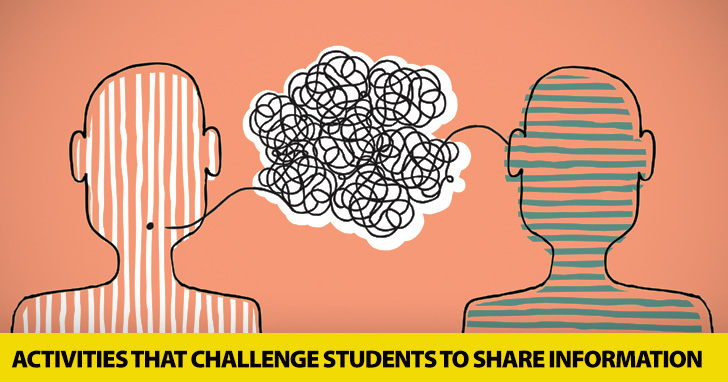I Know Something You Donít: 3 Simple Activities That Challenge Students To Share Information


That’s why I like to give my students as many real communication opportunities as I can during class. It gets them ready for real life language tasks. In this activity, students give information to their classmates and make sure their listeners understand what they heard. It is especially good for motivating them to communicate clearly since their success depends on how well their listeners learn the information they present.

In this first step, students gather the information they will later present to their fellow students. You can do this several different ways, but this is the method I have seen the most success with. I break students into three (or four) groups, making sure I have one simple nonfiction article for each group. I plan to have enough copies of the three different articles so that each person in the large groups has their own copy to read and take notes on. Then I have the three groups read their article together and help each other understand the information. This is similar to how you would start a jigsaw, but there is one main difference. In a jigsaw, each of the three larger groups (in step one) will have different sections of the same written piece – a story or a nonfiction article. In this exercise, I give the three groups unrelated passages to read and present to their classmates. I do this because I want to see how well students communicate their own information to their classmates without having to make connections between each person’s information. If you like, the reading selections you copy for your groups can be on related topics or even on the same topic, but they should be separate articles.
In the second step of this activity, one person presents information to two others in your class. Once all of your groups have read their articles and learned their information, divide your class into groups of three (or four if you originally had four large groups). Each of these new groups should have one member from each of the groups from step one. In other words, if you have articles A, B, and C and their corresponding groups in step one, this new group in step two will have a person who read article A, a person who read article B, and a person who read article C. The person who read article A starts by presenting their information to the other members of their group. These group members cannot read any of A’s article and they cannot take notes on what student A says. They must get all of their information from what A says about his or her article. A can look at his article as much as he likes as he gives the information to his group members.
Once student A has presented his information, students B and C can ask clarifying questions to make sure they understand everything A told them about his article. In fact, you can take the exercise a step further and have students B and C retell the information A presented to them. Once the students are sure they have absorbed all the information their group member has to share with them, go back to step two with student B presenting the information from her article and then again with student C.
Now that your students have shared all of their information with their group members and those members have had a chance to ask questions and retell the information on their own, it’s time to put your money where your mouth is, or at least where your pencil is. Give each student a quiz that covers the information from each of the three articles. While most people will probably do okay on the questions related to their own article, they may not do so well with questions related to their group members’ articles. The real test is not how well individual students perform on their tests. The real measure is how well each person does on the sections they did not read. This will tell you how well each student did communicating their information to their group members. This means that the scores of a student’s group members actually mean more than their own score on the test. If you want to record a grade for this activity, I suggest you take the average of student B and C’s scores on the questions related to article A and record that as the grade for student A. Likewise for students B and C. That is where the real measure of how well they communicated their information lies.
If you like, you can have students complete this last step in their groups of three, or you can have the entire class work together. Hand students’ tests back and discuss the answer to each question. If students got an answer wrong, have the person who first presented that information explain why the answer was incorrect and what the right answer was. Then have the student explain why they chose the wrong answer that they did.
When students read information, they will often remember much of it. But when your students also teach that information to their classmates, they will retain even more and learn it even better. This exercise challenges students to do just that. In addition, students have their classmates depending on them for successful performance on an assessment activity. This will simulate academic or business projects that your students will have to do with coworkers or fellow students. Because each person’s assessment depends on how well his group members perform, this activity will get your students working together and talking to make sure everyone understands all of the information.